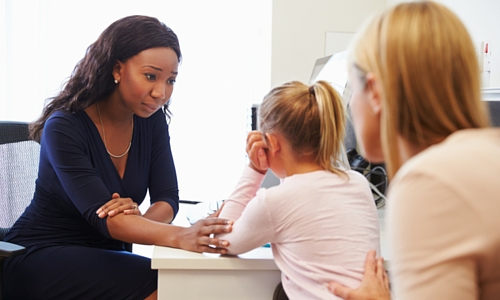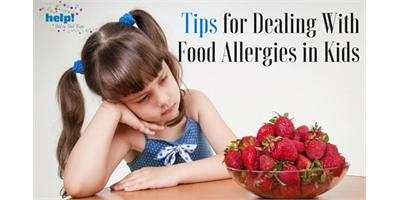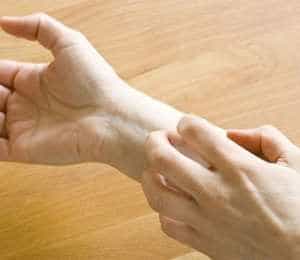May is Food Allergy Awareness Month, so we put together a few tips to help you navigate (and deal with) the many allergens that are affecting kids today.
The rate of allergies appears to be increasing in North America; about 30% of adults are affected and 40% of kids. Chronic conditions that can be managed with prevention and treatment (unfortunately no cures yet!), allergies are one of the most common chronic diseases affecting children under 18.
Because of their prevalence, and the possibility of severe reactions, it’s important to have some running knowledge about how allergies work, whether you have a kid with allergies or not. Below are some tips to help with prevention and avoidance.
Common allergens and types of reactions

An allergy occurs when the body’s immune system reacts to an otherwise non-harmful substance as if it were harmful. The body creates antibodies in response to the presence of the substance, which causes the symptoms of an allergic reaction.
Allergic reactions cause the release of histamine from particular cells in our immune system, and the amount of histamine released (and where it’s released) affects the severity and type of allergic reaction.
Medicines, food, insect bites or stings, and latex are the most common types of allergens. In kids specifically, food allergies are the most common. Peanuts, tree-nuts, shellfish, fish, milk, eggs, soy, and wheat are the most common types of allergen, with milk, eggs, peanuts, soy, and wheat being the most common in children.

Not all allergic reactions are the same. Sometimes the body’s response is mild, including runny nose, watery eyes, hives, or a rash. The reaction can also be more serious and involve swelling in the mouth and throat and trouble breathing. In the most severe cases an allergen can lead to anaphylaxis.
Anaphylaxis is a severe and rapid reaction to exposure to a substance one is allergic to. The reaction often includes more than one part of the body – some symptoms include skin reactions, breathing difficulty, swelling, cramping, and abdominal pain. Anaphylaxis is life threatening and rapid response is necessary.
Immediate treatment is epinephrine. This medication comes in the form of autoinjectors or epipens that you carry with you in case of emergency. They automatically deliver a dose of epinephrine, which stops, stalls, or slows the allergic reaction. Once an epipen is administered it is important to seek further emergency medical care as more treatment may be necessary.
The severity of the allergic reaction can change over time, getting more or less intense. It is important to stay vigilant about food allergies, so take a look at the helpful tips below.
14 TIPS FOR DEALING WITH AN ALLERGY

There is no one size fits all solution for dealing with a family member’s allergy, especially a child. The single most important thing to do is consult with a doctor. Depending on the type and severity of the allergy, you may want or need to have a specialist in Immunology and Allergy on your roster, too.
With the help of your doctors’ you can help narrow down the severity, find the causes, and learn the best steps for treating and avoiding your child’s allergies.
1. Total avoidance
You can choose to not have the allergen in your home at all. For example, if your child is allergic to soy, make sure you never have any products containing soy (check the ingredients list at the grocery store) in the house. That way, at least the home will be a controlled area you can be confident in. This measure may be best if the allergy is severe, or while a child is very young.
Also, kids can get stressed out about allergies, so they will feel better knowing everything at home is safe to eat!
2. Keep it out of reach
You can treat the allergen like you would other household substances that need to be kept out of reach from children (such as cleaning supplies and your chocolate stash). Think high shelves, secure cabinets, or even a locked drawer.
3. Educate
As kids get older, you can talk with them about their allergies (what they are and how to avoid them), both inside and outside the home.
If you have more than one kid in the house, but only one has allergies, consider dividing up chores to minimize accidental contact for the kid with allergies. For example, the child with the food allergy can be excused from the chore of loading the dishwasher or cleaning the sink in case some of their allergen ended up on the dirty dishes (depending on how bad their reaction is).
4. Label everything
Use labels or stickers on food in the pantry, fridge, and freezer to denote which are “safe” and which are “unsafe.” You can use a colour coding system, or have stickers or labels with more specifics written out. It will help the kid(s) relax if they know everything with a red sticker is off-limits.
5. Stay organized
Keep safe foods together and foods with the allergen(s) together and away from the safe foods. If kids pack their own lunches, have the allergen-free snacks in an easily accessible spot.
6. One utensil, one use
If the allergen is in the house, a way to increase safety is to make a rule when it comes to utensils. Never use a utensil for more than one food item without washing it between uses.
For example, if you’re making toast, don’t use the same knife for butter and jam – have a separate knife for both. That way you won’t end up with strawberry jam in the butter when you’ve got a strawberry allergy in the house (or butter in the jam when you’ve got a dairy allergy). Do this for all food items, not just the allergen(s), so that it’s a habit for everyone in the house.
7. Use special dishes and utensils
Purchase specific plates or cups that will only ever be used by the individual with the allergy. For example, a sippy-cup for use only by a child with a milk allergy. That way, you never have to worry about accidental contamination. And kids will feel special having their own dishes.
8. Wash your hands
Always wash hands with soap and water before handling food that is “safe” and allergen free. When any food prep is done or before you head out of the kitchen, wash again with soap and water.
9. Designated eating area
Consider confining all eating to selected areas (the kitchen and dining room, for example) to avoid potential spread of allergen residues throughout the house. Plus, this means no crumbs on the couch!
10. Clean cooking surfaces
Before and after food prep, clean countertops with soap and water, and clean all the cooking utensils and dishes with hot soapy water. If you’re preparing safe and unsafe foods in the same meal, prepare the safe foods first after cleaning.
11. Epipens galore
Keep epipens everywhere. Have a set that stays in the house, one in the bag or purse of each parent and caregiver, one in the child’s backpack, several at the school in any room the child spends time in, and one at any after-school program or childcare location.
12. Make other adults aware
Talk with your child’s school administration and teachers about the allergy and be aware of how the school handles allergies and potential reactions. This also goes for childcare services, and the parents of your kid’s close friends – anywhere they spend a good chunk of time.
13. Written instructions
Have a printed out set of instructions regarding your child’s allergy, including symptoms of exposure, how to treat, and who to call. Give it out to anyone new or unfamiliar with your child’s allergy that will be watching them.
14. Have a detailed plan of action
Talk through what will happen and what you and your family will do if a reaction happens. Work this out with your doctor to make sure you have all your bases covered. If possible, keep a copy of your action plan with your kid all the time (perhaps with their epipen), just in case a reaction happens away from you.
Allergies are a serious business, and it’s important to tailor your approach to the specifics of your situation. Allergies can change and evolve over time, as does your child’s understanding and awareness of them. It’s important to be flexible and adaptive as the situation changes for you and your family. And if you ever have concerns, questions, or doubts – check with your doctor!
Jen Vander Vecht is a writer and soon to be full-time mom. When not crafting four different knitting projects at once, she can be found dumping ingredients into her slow-cooker, walking the dog, watching Doctor Who, or researching cloth diapers. Jen has a Masters of Geography from UofT where she studied Urban Forestry. She has planted hundreds of trees throughout Toronto and the GTA and works with various organizations to improve the state of urban trees.
READ MORE LIKE THIS:
- Kids Allergies 101
- Tips When Entertaining Kids With Severe Allergies
- How to Prep and Freeze Healthy Homemade Food
Keep informed with all our camps coverage and find the perfect camp by searching our Toronto & GTA camps directory.
Sign up for our newsletters to get parenting and family fun articles delivered to you!






We think our 8-year-old daughter is allergic to strawberries, so we’re trying to figure out how to keep her safe and healthy. I am so appreciative of your advice to tell your child’s teacher and school about the allergy, and buy dishes especially for her to use to avoid contamination. We’ll do these things and try to find a food allergy treatment doctor to verify it.
It’s interesting to know that milk, eggs, peanuts, and soy are the most common food that causes allergies in kids. My husband and I will be taking care of my nephew, and we are looking for advice to prevent an accident. I will let him know about the most common allergens and kids to prevent any problem.